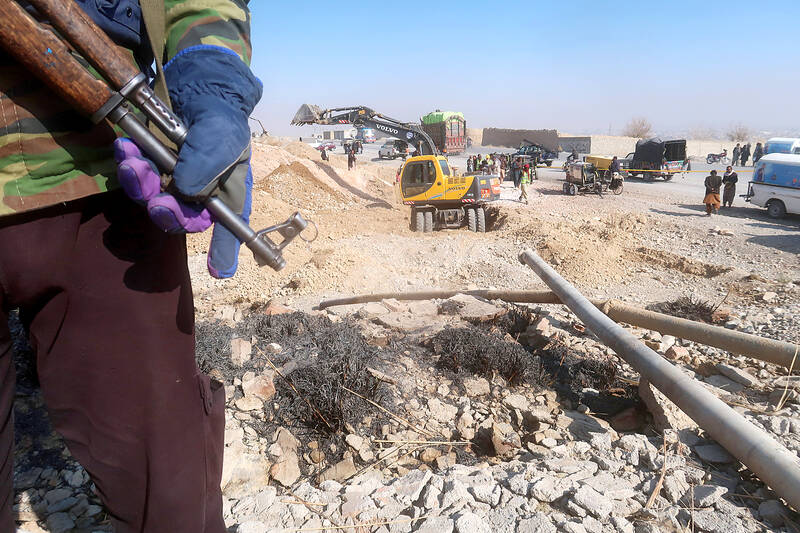Gunmen in southwest Pakistan shot seven bus passengers dead after identifying them as being from another region, officials said yesterday.
Security forces have been battling sectarian, ethnic and separatist violence for decades in Balochistan, which borders Afghanistan and Iran.
Attacks on security forces and ethnic groups have increased sharply in the past few years, especially against laborers from Punjab, the country’s most populous and prosperous province and also a major recruitment base for the military.

Photo: EPA
Attackers late on Tuesday burst the tires of a bus that was traveling through Balochistan along a highway close to the provincial border with Punjab, said Saadat Hussain, a government official in the area.
Gunmen boarded the bus and demanded to see the identity cards of passengers.
“The passengers belonging to Punjab province ... were taken off by the terrorists and killed,” Hussain said. “They were lined up and shot dead.”
No one has claimed responsibility for the attack.
The Balochistan Liberation Army is the most active group in the region, killing six people in a bombing last month. The separatist militants killed at least 39 people in coordinated attacks last year that largely targeted ethnic Punjabis.
In November last year, the group claimed responsibility for a bombing at Quetta’s main railway station that killed 26 people, including 14 soldiers.
The militants have also targeted energy projects with foreign financing accusing outsiders of exploiting the resource-rich region while excluding residents in the poorest part of Pakistan.

Asian perspectives of the US have shifted from a country once perceived as a force of “moral legitimacy” to something akin to “a landlord seeking rent,” Singaporean Minister for Defence Ng Eng Hen (黃永宏) said on the sidelines of an international security meeting. Ng said in a round-table discussion at the Munich Security Conference in Germany that assumptions undertaken in the years after the end of World War II have fundamentally changed. One example is that from the time of former US president John F. Kennedy’s inaugural address more than 60 years ago, the image of the US was of a country

‘UNUSUAL EVENT’: The Australian defense minister said that the Chinese navy task group was entitled to be where it was, but Australia would be watching it closely The Australian and New Zealand militaries were monitoring three Chinese warships moving unusually far south along Australia’s east coast on an unknown mission, officials said yesterday. The Australian government a week ago said that the warships had traveled through Southeast Asia and the Coral Sea, and were approaching northeast Australia. Australian Minister for Defence Richard Marles yesterday said that the Chinese ships — the Hengyang naval frigate, the Zunyi cruiser and the Weishanhu replenishment vessel — were “off the east coast of Australia.” Defense officials did not respond to a request for comment on a Financial Times report that the task group from

BLIND COST CUTTING: A DOGE push to lay off 2,000 energy department workers resulted in hundreds of staff at a nuclear security agency being fired — then ‘unfired’ US President Donald Trump’s administration has halted the firings of hundreds of federal employees who were tasked with working on the nation’s nuclear weapons programs, in an about-face that has left workers confused and experts cautioning that the Department of Government Efficiency’s (DOGE’s) blind cost cutting would put communities at risk. Three US officials who spoke to The Associated Press said up to 350 employees at the National Nuclear Security Administration (NNSA) were abruptly laid off late on Thursday, with some losing access to e-mail before they’d learned they were fired, only to try to enter their offices on Friday morning

STEADFAST DART: The six-week exercise, which involves about 10,000 troops from nine nations, focuses on rapid deployment scenarios and multidomain operations NATO is testing its ability to rapidly deploy across eastern Europe — without direct US assistance — as Washington shifts its approach toward European defense and the war in Ukraine. The six-week Steadfast Dart 2025 exercises across Bulgaria, Romania and Greece are taking place as Russia’s invasion of Ukraine approaches the three-year mark. They involve about 10,000 troops from nine nations and represent the largest NATO operation planned this year. The US absence from the exercises comes as European nations scramble to build greater military self-sufficiency over their concerns about the commitment of US President Donald Trump’s administration to common defense and